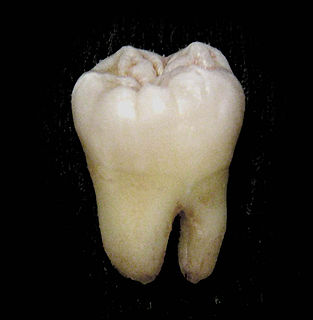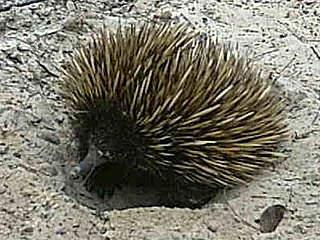
Multituberculata is an extinct taxon of rodent-like allotherian mammals that existed for approximately 166 million years, the longest fossil history of any mammal lineage. They eventually declined from the late Paleocene onwards, disappearing from the known fossil record in the late Eocene, though gondwanatheres lived into the Miocene, and may have been multituberculates. More than 200 species are known, ranging from mouse-sized to beaver-sized. These species occupied a diversity of ecological niches, ranging from burrow-dwelling to squirrel-like arborealism to jerboa-like hoppers. Multituberculates are usually placed as crown mammals outside either of the two main groups of living mammals—Theria, including placentals and marsupials, and Monotremata—but closer to Theria than to monotremes. Nonetheless, at least one study found a potential status as sister taxa to monotremes/Australosphenida.

The molars or molar teeth are large, flat teeth at the back of the mouth. They are more developed in mammals. They are used primarily to grind food during chewing. The name molar derives from Latin, molaris dens, meaning "millstone tooth", from mola, millstone and dens, tooth. Molars show a great deal of diversity in size and shape across mammal groups. The third molar of humans is sometimes vestigial.

Gondwanatheria is an extinct group of mammaliaforms that lived in the Southern Hemisphere, including Antarctica, during the Upper Cretaceous through the Miocene. Until recently, they were known only from isolated teeth, a few lower jaws, two partial skulls and one complete cranium. Because of this fragmentary knowledge, their placement is not clear, although more details have emerged from newer finds and studies.
Ferugliotherium is a genus of fossil mammals in the family Ferugliotheriidae from the Campanian and/or Maastrichtian period of Argentina. It contains a single species, Ferugliotherium windhauseni, which was first described in 1986. Although originally interpreted on the basis of a single brachydont (low-crowned) molar as a member of Multituberculata, an extinct group of small, rodent-like mammals, it was recognized as related to the hypsodont (high-crowned) Sudamericidae following the discovery of additional material in the early 1990s. After a jaw of the sudamericid Sudamerica was described in 1999, these animals were no longer considered to be multituberculates and a few fossils that were previously considered to be Ferugliotherium were assigned to unspecified multituberculates instead. Since 2005, a relationship between gondwanatheres and multituberculates has again received support. A closely related animal, Trapalcotherium, was described in 2009 on the basis of a single tooth.
Lavanify is a mammalian genus from the late Cretaceous of Madagascar. The only species, L. miolaka, is known from two isolated teeth, one of which is damaged. The teeth were collected in 1995–1996 and described in 1997. The animal is classified as a member of Gondwanatheria, an enigmatic extinct group with unclear phylogenetic relationships, and within Gondwanatheria as a member of the family Sudamericidae. Lavanify is most closely related to the Indian Bharattherium; the South American Sudamerica and Gondwanatherium are more distantly related. Gondwanatheres probably ate hard plant material.

Metatheria is a mammalian clade that includes all mammals more closely related to marsupials than to placentals. First proposed by Thomas Henry Huxley in 1880, it is a slightly more inclusive group than the marsupials; it contains all marsupials as well as many extinct non-marsupial relatives.

Steropodon galmani is a prehistoric species of monotreme, or egg-laying mammal, that lived about 105 million years ago (mya) in the Late Cretaceous period. It is one of the oldest monotremes discovered, and is one of the oldest Australian mammal discoveries.
Ferugliotheriidae is one of three known families in the order Gondwanatheria, an enigmatic group of extinct mammals. Gondwanatheres have been classified as a group of uncertain affinities or as members of Multituberculata, a major extinct mammalian order. The best-known representative of Ferugliotheriidae is the genus Ferugliotherium from the Late Cretaceous epoch in Argentina. A second genus, Trapalcotherium, is known from a single tooth, a first lower molariform, from a different Late Cretaceous Argentinean locality. Another genus known from a single tooth, Argentodites, was first described as an unrelated multituberculate, but later identified as possibly related to Ferugliotherium. Finally, a single tooth from the Paleogene of Peru, LACM 149371, perhaps a last upper molariform, and a recent specimen from Mexico, may represent related animals.

The Australosphenida are a proposed infraclass of mammals within subclass Yinotheria. Today, there are only five surviving species, which live in Australia and New Guinea, but fossils have been found in Madagascar and Argentina. The surviving species consist of the platypus and four species of echidna. Contrary to other known crown mammals, they retained postdentary bones as shown by the presence of a postdentary trough. The extant members (monotremes) developed the mammalian middle ear independently.
Ausktribosphenidae is a family of mammals from the Early Cretaceous of Australia that are closely related to monotremes.

Dryolestida is an extinct order of mammals; most of the members are mostly known from the Jurassic to Paleogene, with one member, Necrolestes, surviving as late as the early Miocene. They are considered members of the clade Cladotheria, close to the ancestry of therian mammals. It is also believed that they developed a fully mammalian jaw and also had the three middle ear bones. Other than that, not much is known about them, this is because their fossils are made up mostly of jaw and tooth remains.

Monotremes are one of the three main groups of living mammals, along with placentals (Eutheria) and marsupials (Metatheria). The monotremes are typified by structural differences in their brains, jaws, digestive tract, reproductive tract, and other body parts compared to the more common mammalian types. In addition, they lay eggs rather than bearing live young, but, like all mammals, the female monotremes nurse their young with milk.

Ambondro mahabo is a mammal from the Middle Jurassic (Bathonian) Isalo III Formation of Madagascar. The only described species of the genus Ambondro, it is known from a fragmentary lower jaw with three teeth, interpreted as the last premolar and the first two molars. The premolar consists of a central cusp with one or two smaller cusps and a cingulum (shelf) on the inner, or lingual, side of the tooth. The molars also have such a lingual cingulum. They consist of two groups of cusps: a trigonid of three cusps at the front and a talonid with a main cusp, a smaller cusp, and a crest at the back. Features of the talonid suggest that Ambondro had tribosphenic molars, the basic arrangement of molar features also present in marsupial and placental mammals. It is the oldest known mammal with putatively tribosphenic teeth; at the time of its discovery it antedated the second oldest example by about 25 million years.
UA 8699 is a fossil mammalian tooth from the Cretaceous of Madagascar. A broken lower molar about 3.5 mm (0.14 in) long, it is from the Maastrichtian of the Maevarano Formation in northwestern Madagascar. Details of its crown morphology indicate that it is a boreosphenidan, a member of the group that includes living marsupials and placental mammals. David W. Krause, who first described the tooth in 2001, interpreted it as a marsupial on the basis of five shared characters, but in 2003 Averianov and others noted that all those are shared by zhelestid placentals and favored a close relationship between UA 8699 and the Spanish zhelestid Lainodon. Krause used the tooth as evidence that marsupials were present on the southern continents (Gondwana) as early as the late Cretaceous and Averianov and colleagues proposed that the tooth represented another example of faunal exchange between Africa and Europe at the time.
Sudamericidae is a family of gondwanathere mammals that lived during the late Cretaceous to Miocene. Its members include Lavanify and Vintana from the Cretaceous of Madagascar, Bharattherium (=Dakshina) from the Cretaceous of India, Gondwanatherium from the Cretaceous of Argentina, Sudamerica from the Paleocene of Argentina, and unnamed forms from the Eocene of Antarctica and Cretaceous of Tanzania. More recently, Patagonia, a mammal from the Colhuehuapian stage of the Miocene of southern South America, has been suggested to be a sudamericid.

Galulatherium is an extinct genus of gondwanathere mammal, from the Late Cretaceous (Turonian-Campanian)-aged Galula Formation of Tanzania. It is known solely from the type specimen TNM 02067 a fragmentary fossil dentary. The short, deep bone is about 19.5 mm (0.77 in) long, but the back part is broken off. It contains a large, forward-inclined incisor with a root that extends deep into the jaw, separated by a diastema (gap) from five cheekteeth. Very little remains of the teeth, but enough to determine that they are hypsodont (high-crowned). The third cheektooth is the largest and the roots of the teeth are curved. First described in 2003, TNM 02067 has been tentatively identified as a sudamericid—an extinct family of high-crowned gondwanathere mammals otherwise known from South America, Madagascar, India, and Antarctica. If truly a gondwanathere, it would be the only African member of the group and may be the oldest. The describers could not exclude other possibilities, such as that the jaw represents some mammalian group known only from younger, Cenozoic times. In 2019 the fossil was CT scanned, which revealed additional details of the specimen.
Argentodites is a possible multituberculate mammal from the Cretaceous of Argentina. The single species, Argentodites coloniensis, is known from a single blade-like fourth lower premolar (p4) from the La Colonia Formation, which is mostly or entirely Maastrichtian in age. The p4 is 4.15 mm long and bears eight cusps on its upper margin and long associated ridges on both sides. The enamel consists of prisms that are completely or partly surrounded by a sheath and that are on average 6.57 μm apart. Zofia Kielan-Jaworowska, who described and named the fossil in 2007, regarded it as a multituberculate, perhaps a cimolodontan—and thus, a member of a mostly Laurasian (northern) group and an immigrant to Argentina from North America—on the basis of the shape of the tooth and features of its enamel. In 2009, however, two teams argued that Argentodites may in fact be close to or identical with Ferugliotherium, a member of the small Gondwanan (southern) group Gondwanatheria; although their relationships are disputed, gondwanatheres may themselves be multituberculates.
LACM 149371 is an enigmatic fossil mammalian tooth from the Paleogene of Peru. It is from the Santa Rosa fossil site, which is of uncertain age but possibly late Eocene or Oligocene. The tooth is poorly preserved and may have been degraded by acidic water or because it passed through a predator's digestive tract. Its largest dimension is 2.65 mm. It is triangular in shape and bears six cusps that surround the middle of the tooth, where there are three basins (fossae). Crests connects the cusps and separate the fossae. The microscopic structure of the enamel is poorly preserved.

Paratheria is an obsolete term for a taxonomic group including the xenarthran mammals and various groups thought to be related to them. It was proposed by Oldfield Thomas in 1887 to set apart the sloths, anteaters, armadillos, and pangolins, usually classified as placentals, from both marsupial and placental mammals, an arrangement that received little support from other workers. When teeth of the extinct gondwanathere mammals were first discovered in Argentina in the 1980s, they were thought to be related to xenarthrans, leading to renewed attention for the hypothesis that xenarthrans are not placentals. However, by the early 1990s, gondwanatheres were shown to be unrelated to xenarthrans, and xenarthrans are still considered to be placentals.

Yinotheria is a proposed basal subclass clade of crown mammals uniting the Shuotheriidae, an extinct group of mammals from the Jurassic of Eurasia, with Australosphenida, a group of mammals known from the Jurassic to present of Gondwana, including living monotremes. Today, there are only five surviving species of monotremes which live in Australia and New Guinea, consisting of the platypus and four species of echidna. Fossils of yinotheres have been found in England, China, Russia, Madagascar and Argentina. Contrary to other known crown mammals, they retained postdentary bones as shown by the presence of a postdentary trough. The extant members (monotremes) developed the mammalian middle ear independently.












